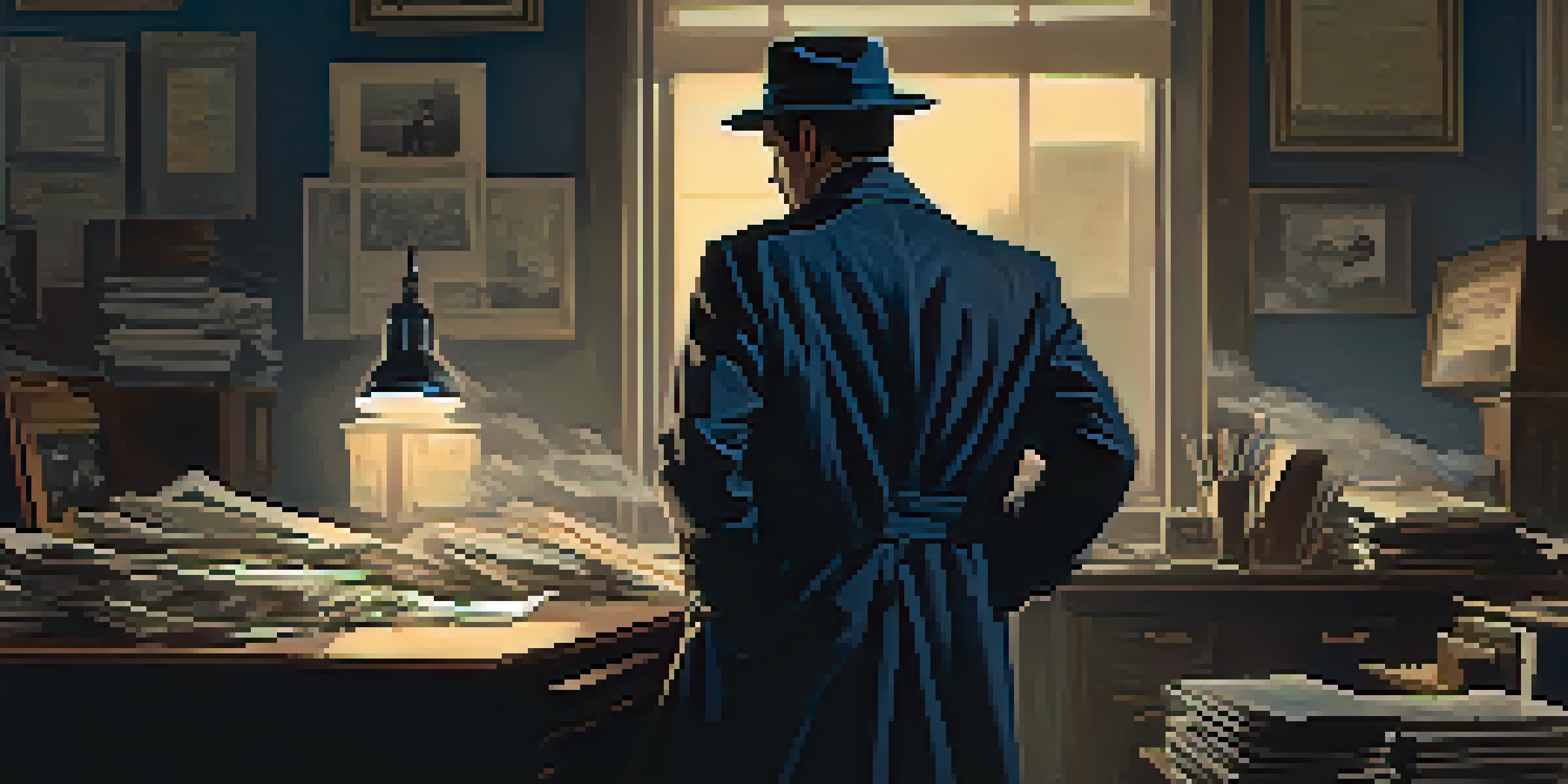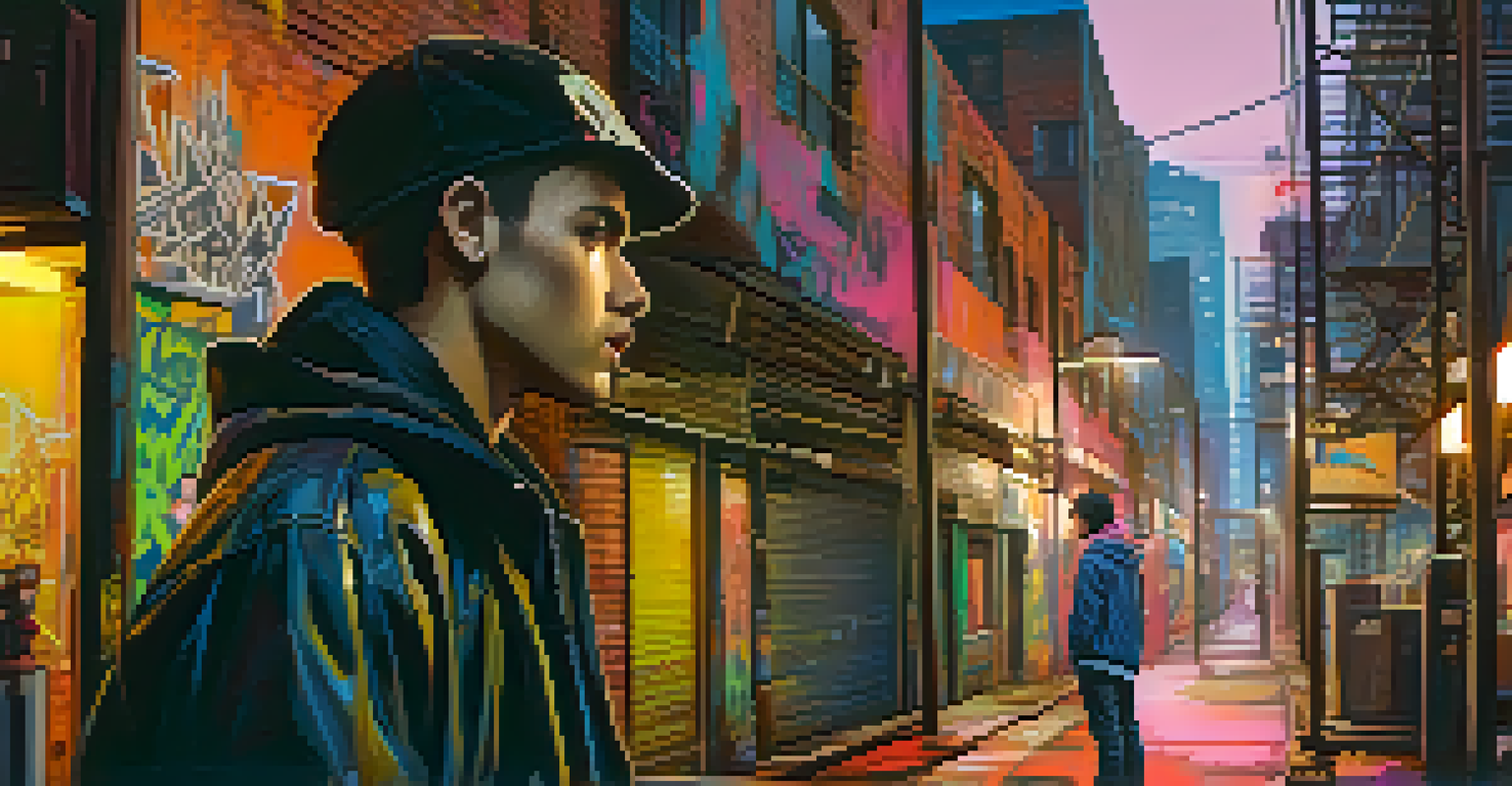The Evolution of the Antihero in Film History

The Birth of the Antihero: Early Cinema's Rebels
The concept of the antihero began to take shape in the early days of cinema. Characters like the outlaw in silent films showcased a rebellious spirit, often breaking societal norms. These early antiheroes, such as D.W. Griffith's 'The Birth of a Nation' (1915), highlighted the complexity of morality even in their simplistic narratives.
The antihero is a reflection of how we see ourselves, our flaws, and our struggles.
As film evolved, so did the portrayal of these characters. The 1930s introduced more nuanced antiheroes like Bogart's Sam Spade in 'The Maltese Falcon' (1941), who embodied both charm and moral ambiguity. Audiences were captivated by protagonists who didn't fit the traditional hero mold, sparking a shift in storytelling.
This era laid the groundwork for the modern antihero, showing viewers that sometimes the lines between good and evil are blurred. With each film, the antihero began to challenge the expectations of heroism, inviting audiences to explore their own moral dilemmas.
Film Noir: The Antihero in Shadows and Grit
The film noir genre of the 1940s and 1950s further developed the antihero archetype, steeped in darkness and moral complexity. Characters like the hard-boiled detective or the femme fatale often found themselves trapped in a world of crime and corruption. This gritty realism resonated with audiences who were grappling with post-war disillusionment.

In films like 'Double Indemnity' (1944), the antihero was often driven by flawed desires, highlighting their vulnerability. These characters' struggles against overwhelming odds made them relatable, as they navigated a landscape filled with betrayal and greed. They became symbols of existential angst, reflecting the uncertainties of the time.
Antiheroes Redefine Heroism in Film
From early cinema to the present, antiheroes have challenged traditional notions of good and evil, inviting audiences to explore complex moral dilemmas.
The allure of noir's antiheroes lies in their imperfections and the choices they make. This genre not only entertained but also challenged viewers to confront their own ethical beliefs, further solidifying the antihero's role in cinematic storytelling.
The 1960s and 1970s: Counterculture Antiheroes
As societal norms began to shift in the 1960s and 1970s, so did the antihero. Films like 'Bonnie and Clyde' (1967) and 'Easy Rider' (1969) introduced characters who rejected mainstream values. These counterculture antiheroes became symbols of rebellion, embodying the spirit of a generation seeking change.
In a world where good and evil are often blurred, the antihero's journey provides a canvas for exploring complex moral landscapes.
Audiences were drawn to their charm and charisma, even as they engaged in morally questionable actions. This period saw the antihero evolve from a mere rebel to a complex character grappling with societal issues, reflecting the turmoil of the era. Their stories often highlighted the struggle against an oppressive system, resonating deeply with viewers.
This transformation paved the way for a new understanding of heroism in cinema. The counterculture antiheroes challenged traditional narratives and encouraged audiences to question the status quo, further enriching the antihero's legacy.
The Rise of the Antihero in the 1980s and 1990s
The 1980s and 1990s ushered in a new wave of antiheroes, characterized by their complexity and depth. Films like 'Scarface' (1983) and 'The Usual Suspects' (1995) introduced protagonists whose flaws made them intriguing. These characters often operated outside the law, yet their motivations provided a glimpse into their struggles.
Audiences found themselves rooting for these antiheroes, even as they engaged in morally dubious behavior. The rise of the antihero during this time reflected a growing fascination with flawed characters who challenged conventional morality. Their stories often served as cautionary tales, showcasing the consequences of their choices.
Antiheroes Reflect Societal Issues
Flawed characters serve as a lens for social commentary, addressing important topics like corruption and inequality while prompting viewers to confront their own values.
By embracing the antihero's complexity, filmmakers invited viewers to explore the darker aspects of human nature. This era solidified the antihero's place in film history, showcasing the multifaceted nature of morality.
The 21st Century: Antiheroes in a Global Context
As we moved into the 21st century, the antihero continued to evolve, often reflecting global issues and cultural shifts. Characters like Walter White from 'Breaking Bad' and Tony Soprano from 'The Sopranos' emerged, showcasing the moral ambiguity prevalent in modern storytelling. These characters were not just flawed; they were deeply human, grappling with their choices and their consequences.
The rise of streaming platforms also allowed for more nuanced character development, enabling viewers to connect with antiheroes over extended narratives. This shift meant audiences could witness the evolution of these characters in real-time, fostering a deeper understanding of their motivations and conflicts.
The global context has also introduced diverse antiheroes from various cultures, enriching the narrative landscape. This evolution underscores the antihero's ability to adapt and thrive across different storytelling mediums, resonating with audiences worldwide.
The Antihero and Social Commentary
One of the most compelling aspects of the antihero is their ability to serve as a vehicle for social commentary. Through flawed characters, filmmakers can address complex societal issues, such as corruption, inequality, and moral dilemmas. Antiheroes often reflect the struggles of the times, providing audiences with a lens through which to examine their own realities.
For example, films like 'Joker' (2019) explore themes of mental illness and societal neglect, using the antihero's journey to spark important conversations. These narratives challenge viewers to confront uncomfortable truths about the world around them, making the antihero a powerful storytelling tool.
Future of Antiheroes Looks Diverse
As storytelling evolves with new technologies, antiheroes will continue to adapt, providing richer narratives that resonate with a changing cultural landscape.
By engaging with these themes, the antihero has become a mirror for society, encouraging audiences to reflect on their own values and beliefs. This ability to provoke thought and discussion is what makes the antihero a vital component of modern cinema.
The Future of the Antihero in Film
Looking ahead, the antihero's evolution shows no signs of slowing down. As filmmakers continue to explore the complexity of human nature, we can expect to see even more diverse representations of antiheroes. The cultural landscape is shifting, and with it, the narratives surrounding morality and heroism will adapt.
New technologies and platforms will also play a role in shaping the antihero's future. The rise of virtual reality and interactive storytelling may allow audiences to engage with antiheroes in unprecedented ways, deepening their connection to these complex characters. This evolution will likely lead to richer narratives and a broader exploration of moral ambiguity.

Ultimately, the antihero's journey is a reflection of our own struggles and complexities. As society continues to change, so too will the stories we tell, ensuring that the antihero remains a relevant and captivating figure in the world of film.